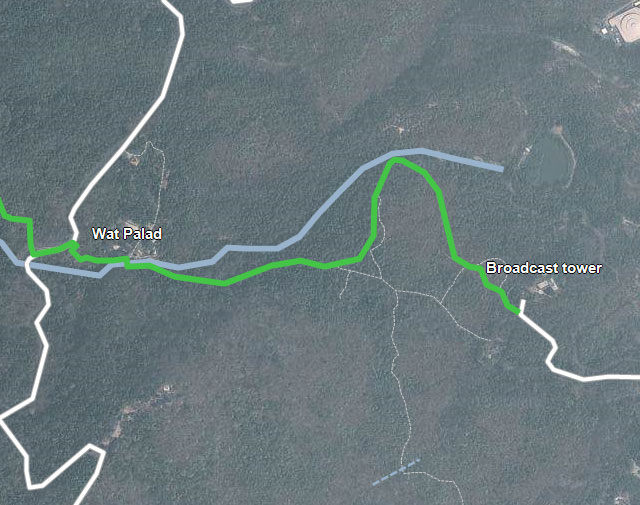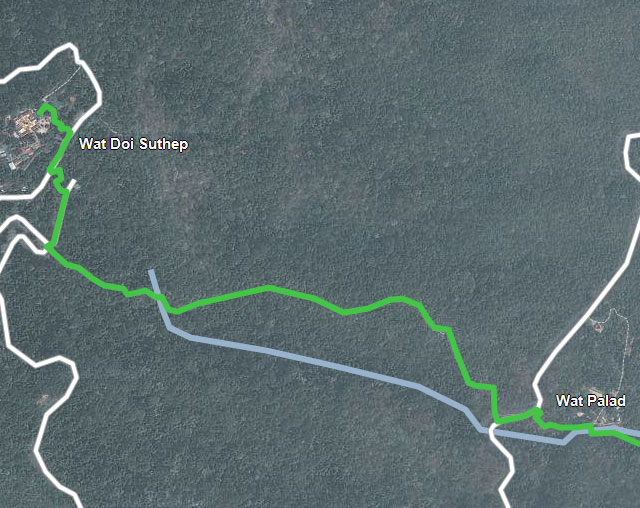The Wat Palad hike
 Since my joint problems prevent me from doing serious strength training in the gym, I've focused on low impact endurance training instead. I've never been really good at it, or even liked it, so I thought it would be an interesting challenge. I used to do a lot of hiking in the past, but usually just for fun with no goal in mind. I guess I had a fairly ok cardiovascular fitness, but nowhere near real athletic standards.
Since my joint problems prevent me from doing serious strength training in the gym, I've focused on low impact endurance training instead. I've never been really good at it, or even liked it, so I thought it would be an interesting challenge. I used to do a lot of hiking in the past, but usually just for fun with no goal in mind. I guess I had a fairly ok cardiovascular fitness, but nowhere near real athletic standards.
I remember that when I did my military service at age 20 we ran a 10 km forest track once a week. 52 minutes at my first try, and five months later I finished the track in 42 minutes. Pretty ok since I had never done serious endurance training before. But my body weight was 70 kg, not 96 kg as it is today, and that is a lot of additional weight to move around.
Now I have been at it for two and a half months. I set up a strict regimen of mountain hiking every other morning, where I push myself very hard, and gym treadmill exercise the rest of the mornings where I push myself moderately. Plus I have done one hour of walking in the park every evening, not so much for endurance training, but to keep active since I sit so much while working. I have taken the gym day off when ever I feel extra tired, to let my body get some rest. So far it has been on average once a week.
The trail
The Wat Palad Nature Trail takes me from a broadcast tower at the foot of the mountain, on a winding trail up to the Wat Palad temple, as shown below.
 This is only a 18 minute hike at a moderate tempo (and 18 minutes back), so I did this the first two weeks to ease into the training.
This is only a 18 minute hike at a moderate tempo (and 18 minutes back), so I did this the first two weeks to ease into the training.
Then the trail continues onto tarmac for 100 m, and into the forest again. This time it gets rough with several really steep sections that are quite challenging, see below.
 For the following month and a half I hiked up to the small river marked on the map. And then I extended the hike further all the way up to the temple.
For the following month and a half I hiked up to the small river marked on the map. And then I extended the hike further all the way up to the temple.
In case you want to do the hike, the last part is a bit tricky: When you reach the main road, you walk through a gate and uphill on a paved road. Before the road ends at a house, you take stairs to the left, which then turn in to a very small track which is a shortcut up to the next paved road. You follow that road for 100 m and then take the metal stairs to the left, go straight up as far as you can, and then turn right, continue forward and around the corner to the left, climb two stairs, and you are at the top, right at the temple and the scenic view point.
Results
It has been a very rewarding experience. I remember the first time I walked this trail eight years ago, and I couldn't even get past the first steep passage 350 m into the trail. I had to stop twice to catch my breath. This time I was in a bit better condition when I started the program, but I still got very tired after only walking in slow pace up to the first temple. Each week the trail felt a bit easier, and this really is an awesome feeling of improvement. It went in stages: A) Breathing really hard and feeling like "I can’t take it anymore". B) Breathing equally hard, but feeling like my body was used to hard breathing now. C). Breathing slower and catching up very quickly after the steepest parts.
I have pushed myself very hard on these hikes, to really make it about cardiovascular training. I made a pact with myself to never ever stop and rest anywhere along the path, not even for a second. "If it gets too rough, then lower the tempo, but never ever stop." I visualized pictures from the old Kung fu movie "No retreat, no surrender" with Van Damme, to try and feel like a bad ass.
I just recently started to measure my progress, and I've also used a heart rate monitor. The data was very surprising. My HR-rest is 45 and HR-max 170. It turns out that on an average hike I only spend 28% of the time in the aerobic zone (70-80% of HR-max). 37% of the time I'm in the anaerobic zone (80-90% of HR-max) and 21% of the time I'm in the "danger" zone (90-100% of HR-max). Clearly not optimal for endurance training, where you want to spend the majority in the aerobic zone, because that has the most benefit on your endurance. You also want to spend no time at all in the "danger" zone because it reliably leads to injuries and over-training. I have had some headaches lately and it is probably because of this, so the message is clear: take it easier.
Despite this, I am happy about the program so far. The hike feels a lot easier now, and I've lost 4 kg of body weight. My resting heart rate went from around my normal 55 to 45 bpm.
My best time for the hike is 45 minutes 10 seconds, and this is when I push myself to the max. It is a 3.4 km long trail, with a 600 m ascend, which makes it on average a 18% grade incline. I wonder how this compares to running? I suspect this trail is as tough as running 10 km, resulting in approximately the same time.
